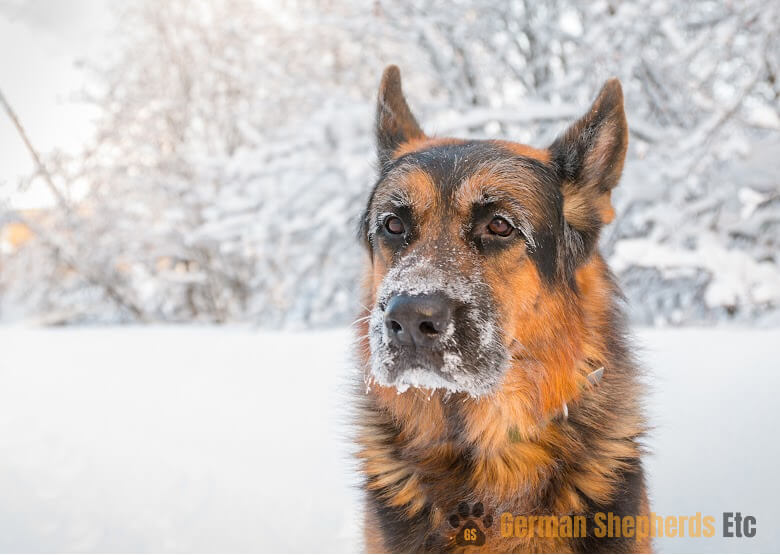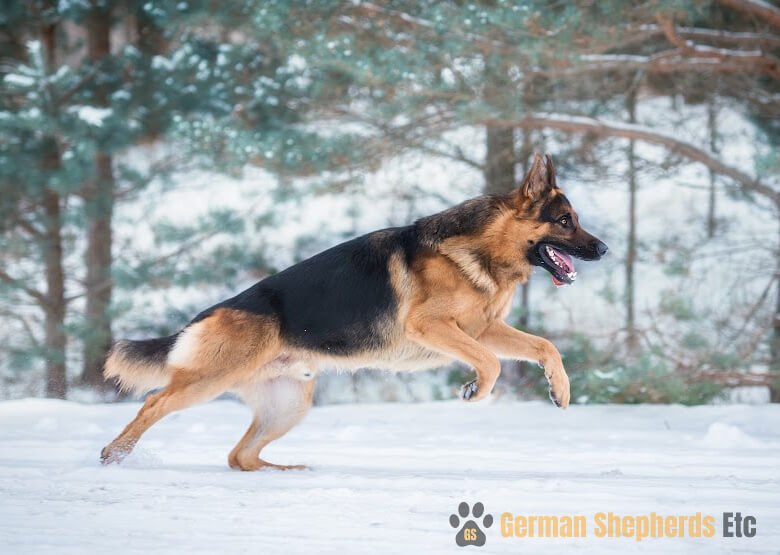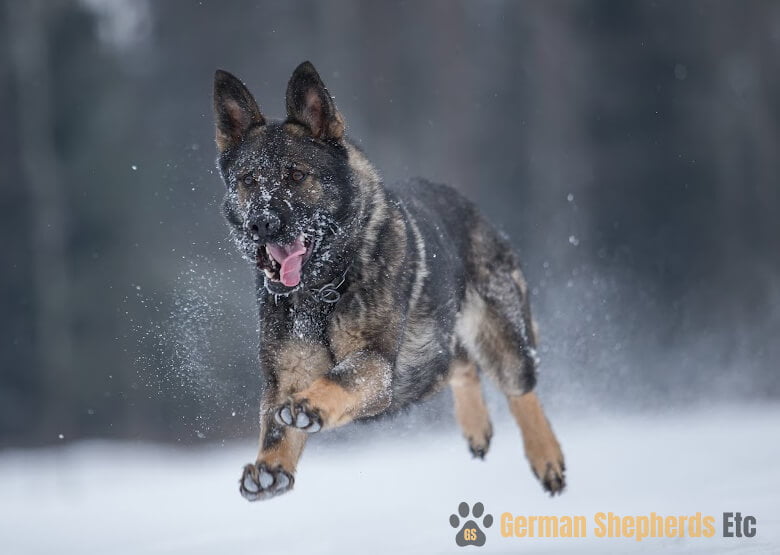Table of Contents
As German Shepherd owners, you may often wonder, how cold is too cold for my dog? Understanding their natural resilience to chilly weather is important to ensure that you’re providing them with the proper care during cold months. It’s crucial to remember that factors such as age, health conditions, activity level, and weight can affect a German Shepherd’s ability to withstand cold weather.
Keep in mind that your dog’s tolerance for cold may vary depending on individual factors, so always be attentive to their well-being during low-temperature conditions.
German Shepherd Cold Tolerance
How Cold is Too Cold for a German Shepherd: Temperature Range and Limits
Your German Shepherd can tolerate a range of temperatures, thanks to its double-layered coat. Generally, most German Shepherds can handle temperatures as low as 30 °F (-1 °C). Long-haired German Shepherds can even withstand colder temperatures due to their thicker coats. However, when temperatures go below 20 °F (-7 °C), the weather becomes dangerous for your German Shepherd. Ideally, a comfortable temperature range for your furry friend is between 50 °F (10 °C) and 86 °F (30 °C).
Factors Affecting Cold Tolerance
A variety of factors can influence your German Shepherd’s cold tolerance:
- Coat Type: German Shepherds have thick double coats which insulate the dog against cold temperatures. Long-haired German Shepherds can withstand colder temperatures due to their dense fur.
- Age: Older dogs and puppies may have more difficulty handling colder temperatures because their body fat and metabolism may be different from adult dogs. Always monitor your dog’s comfort during cold weather, especially if they are very young or old.
- Size: Larger German Shepherds may be more resistant to cold temperatures because they have a greater body mass, which can help generate heat.
- Health: If your German Shepherd has any health issues or a compromised immune system, it may be more susceptible to cold-related illnesses, such as hypothermia.
- Adaptation: Your German Shepherd can acclimate to different temperatures over time. If your dog is exposed to cold temperatures gradually and consistently, it will better adapt to colder weather and be able to tolerate a wider range of temperatures.
To ensure your German Shepherd’s safety and comfort in cold weather, always monitor their behavior and body language. Provide adequate shelter, water, and warmth, and consult a veterinarian if you have concerns about your dog’s cold tolerance.
Adaptation To Cold Weather

Coat Characteristics
Your German Shepherd’s ability to tolerate cold weather mainly comes from their unique coat characteristics. They possess a double coat that consists of a dense undercoat and an outer coat made up of longer guard hairs. The undercoat provides insulation against the cold, while the guard hairs offer protection from moisture and dirt. This coat structure allows them to withstand temperatures as low as 30 °F (-1 °C).
During the winter months, your German Shepherd’s coat will naturally become thicker, providing them with even better protection against the cold. The bushy tail also serves as an additional feature that helps to conserve body heat by wrapping it around their body when in a resting position.
Behavioral Adaptation
Aside from their impressive coat characteristics, German Shepherds also demonstrate certain behaviors that help them adapt to colder temperatures. Here are a few:
- Seeking shelter: Your German Shepherd will instinctively find sheltered spots to rest in when the weather gets colder. This could include finding a cozy spot indoors or seeking cover from wind and snow outdoors.
- Curling up: You may notice your GSD curling up tightly when resting in colder temperatures. This behavior helps conserve body heat by reducing body surface area exposed to the cold.
- Increased activity level: German Shepherds tend to be more active during colder months. Remaining active helps generate body heat, which in turn keeps them warm and better adapted to the cold weather.
Effect Of Age On Cold Tolerance
German Shepherds are known for their cold tolerance, but age plays a significant role in how well they can handle harsh temperatures.
Puppies
Puppies are more sensitive to cold temperatures than adult German Shepherds. Their bodies are still developing, and they lack the full double coat that protects adult German Shepherds from the cold. As a result, puppies may struggle to maintain their body temperature when exposed to temperatures below 30 °F (-1 °C).
To keep your German Shepherd puppy warm and keep the cold from reaching their body, you should:
- Provide a warm, dry shelter where they can escape the cold
- Use blankets or dog beds to insulate against cold surfaces
- Limit their time outdoors in extremely cold weather
- Dress them in a dog sweater or coat if necessary
Keep a close eye on your puppy when they are outdoors and bring them inside if they show signs of discomfort or shivering.
Older Dogs
A senior German Shepherd may also be more susceptible to the cold due to health issues, a decrease in activity levels, or loss of muscle mass which may make it harder for them to generate body heat. Like puppies, older dogs may not be able to withstand temperatures as low as adult German Shepherds can. Check for cold-related health issues such as arthritis, which can be aggravated by cold weather.
Dangers Of Extreme Cold
Hypothermia And Frostbite
As a German Shepherd owner, it’s essential to be aware of the potential dangers that can arise in extremely cold weather. Prolonged exposure to freezing temperatures and snow increases the risk of your dog developing hypothermia and frostbite.
Hypothermia occurs when your dog’s body temperature drops below its normal range, which can lead to shivering, weakness, and even unconsciousness if left untreated. Similarly, frostbite is a result of prolonged exposure to frigid temperatures, and it affects your dog’s extremities, such as the ears, tail, and paws, causing tissue damage and potential long-term harm.
Recognizing Symptoms
It’s crucial to recognize the symptoms of hypothermia and frostbite in your German Shepherd to take appropriate action and ensure their wellbeing. Here are some signs to look out for:
- Shivering: This is a primary indicator of cold weather discomfort and the onset of hypothermia. If your German Shepherd is shivering excessively, it’s time to get them out of the cold and into a warm environment.
- Lethargy: If your dog appears weak, unresponsive, or disoriented, this may indicate their body temperature has dropped significantly, and they are experiencing hypothermia.
- Pale or discolored skin: This could be a sign of frostbite, particularly on the extremities like the ears, tail, and paws. If the skin appears different from usual and feels cool to the touch, it may be due to frostbite.
- Swelling or blisters: These could also indicate frostbite, as the affected tissues might become swollen or even develop blisters.
To reduce the risk of hypothermia and frostbite, keep an eye on the weather conditions and limit your German Shepherd’s time outdoors during extreme cold.
Protecting Your German Shepherd During Winter

As it gets cold outside, it’s crucial to provide some extra care to keep your German Shepherd warm in winter. Here are some practical ways to ensure their comfort and health during winter months:
Shelter And Bedding Options
To make your German Shepherd stay warm when it’s cold outside, ensure you provide an adequate shelter from the cold. If they spend a significant amount of time outdoors, provide a waterproof and insulated dog house to protect them from snow, ice, and wind. Provide thick, warm blankets or a cozy dog bed for your pet to snuggle in, and ensure that their sleeping area is sheltered from drafts and raised off the cold ground.
In colder temperatures, consider bringing your dog indoors to keep them warm and safe. Keep an eye on the temperature outside and keep your German Shepherd out of the cold for extended periods when the temperature drops below 30 °F (-1 °C).
Proper Nutrition And Exercise
Maintaining a nutritious diet plays a crucial role in keeping your German Shepherd healthy during winter. Cold weather requires more energy for your dog to keep warm, so consider increasing their food intake slightly, especially if they spend a lot of time outside. Ensure that your German Shepherd has access to clean, fresh water at all times, as dehydration can make them more susceptible to cold-weather illnesses.
Regular exercise is essential for your German Shepherd’s well-being, even during winter months. However, make sure to keep your walks and outdoor play sessions shorter in colder weather to prevent overexposure. Monitor your dog for signs of discomfort, such as shivering or reluctance to move, and make sure to dry them off thoroughly after being out in the wet or snowy conditions.
In addition, maintaining a proper grooming routine can help to keep your German Shepherd’s coat healthy and insulated. Regular brushing helps to remove dead hair and stimulates the growth of new, warm fur. Avoid shaving or cutting your dog’s hair too short during winter months, as their thick coat provides essential insulation against the cold.
By following these tips and paying close attention to your German Shepherd’s needs, you can ensure that your furry friend stays warm and comfortable during the winter season.
Dog Boots and Clothing
During colder months, it’s essential to provide your German Shepherd with additional coverings, such as dog boots and clothing. These items help protect their feet from the cold ground and keep their body temperature stable. Make sure to properly measure and select the appropriate size for your dog for maximum comfort. When choosing dog boots or jackets, look for waterproof and insulated materials, as these will best protect your pet from the elements.
Avoiding Common Hazards
While winter can be an enjoyable time for your German Shepherd, certain hazards should be avoided to ensure their health and safety. Here are a few tips:
- Climate: Be aware of the cold climate and its effect on your dog. Monitor your German Shepherd’s behavior and look for signs of discomfort, such as shivering or whining. Bring them inside if you notice any signs of hypothermia or discomfort.
- Water Bowl: Prevent your dog’s water bowl from freezing by using a heated water dish or by periodically replacing the water. Keeping your dog hydrated is essential for their overall health.
- Doghouse: If your German Shepherd spends any time outdoors in their doghouse during the winter, make sure it is well-insulated and draft-free. Provide them with a warm and dry bed to help maintain their body temperature.
- Salt: Roads and sidewalks are often treated with salt and other chemicals during the winter months. These substances can be harmful if ingested or in contact with your dog’s paws. When coming back from walks, thoroughly wipe your dog’s feet to remove potential irritants.
Remember, being mindful of your German Shepherd’s comfort during cold climates is crucial. By monitoring their body temperature and making a few small adjustments, you can ensure a safe and enjoyable winter experience for you and your furry friend.
